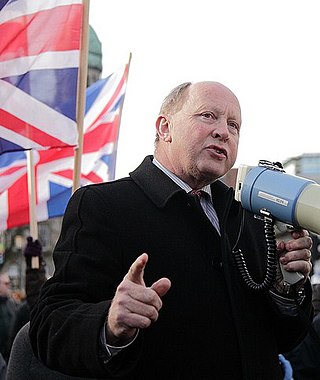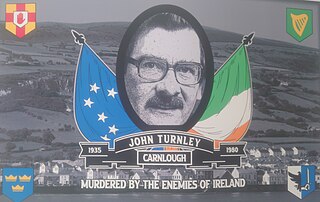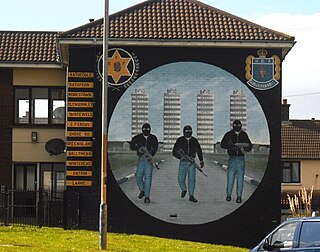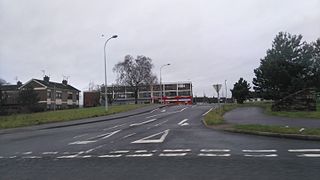
County Antrim is one of the six counties of Northern Ireland, located within the historic province of Ulster. Adjoined to the north-east shore of Lough Neagh, the county covers an area of 3,086 square kilometres (1,192 sq mi) and has a population of 651,321, as of the 2021 census. County Antrim has a population density of 211 people per square kilometre or 546 people per square mile. It is also one of the thirty-two traditional counties of Ireland.

The Loyalist Volunteer Force (LVF) was an Ulster loyalist paramilitary group in Northern Ireland. It was formed by Billy Wright in 1996 when he and his unit split from the Ulster Volunteer Force (UVF) after breaking its ceasefire. Most of its members came from the UVF's Mid-Ulster Brigade, which Wright had commanded. In a two-year period from August 1996, the LVF waged a paramilitary campaign in opposition to Irish republicanism and the Northern Ireland peace process. During this time it killed at least 14 people in gun and bomb attacks, almost all of them Catholic civilians killed at random. The LVF called off its campaign in August 1998 and decommissioned some of its weapons, but in the early 2000s a loyalist feud led to several killings. Since then, the LVF has been largely inactive, but its members are believed to have been involved in rioting and organized crime. In 2015, the security forces stated that the LVF "exists only as a criminal group" in Mid-Ulster and Antrim.

Larne is a town on the east coast of County Antrim, Northern Ireland, with a population of 18,853 at the 2021 census. It is a major passenger and freight roll-on roll-off port. Larne is administered by Mid and East Antrim Borough Council. Together with parts of the neighbouring districts of Antrim and Newtownabbey and Causeway Coast and Glens, it forms the East Antrim constituency for elections to the Westminster Parliament and Northern Ireland Assembly. The civil parish is in the historic barony of Glenarm Upper.

James Hugh Allister is a British Unionist politician and barrister in Northern Ireland. He founded the Traditional Unionist Voice (TUV) political party in 2007, leading the party since its formation. Allister has served as a Member of the Northern Ireland Assembly (MLA) for North Antrim since 2011, and is the TUV’s only representative in the Assembly.

East Antrim is a parliamentary constituency in the United Kingdom House of Commons. The current MP is Sammy Wilson of the DUP.

The Orange Volunteers (OV) or Orange Volunteer Force (OVF) is a small Ulster loyalist paramilitary group in Northern Ireland. It was formed in 1998 by loyalists who opposed the Belfast Agreement and the loyalist ceasefires. Over the following year it carried out a wave of bomb and gun attacks on Catholics and Catholic-owned properties in rural areas, but since 2000 has been relatively inactive. The group has been associated with elements of the Orange Order and has a Calvinist fundamentalist ideology. OV's original leader was Clifford Peeples. The OV are a Proscribed Organisation in the United Kingdom under the Terrorism Act 2000 and have been included on the U.S. State Department's, "Terrorist Exclusion List", since 2001.

Newtownabbey is a large settlement north of Belfast city centre in County Antrim, north of Ireland. It is separated from the rest of the city by Cavehill and Fortwilliam golf course, but it still forms part of the Belfast metropolitan area. It surrounds Carnmoney Hill, and was formed from the merging of several small villages including Whiteabbey, Glengormley and Carnmoney. At the 2021 census, Metropolitan Newtownabbey Settlement had a population of 67,599, making it the third largest settlement in Northern Ireland and seventh on the Island of Ireland. It is part of Antrim and Newtownabbey Borough Council.

Ballymena is a town in County Antrim, Northern Ireland. It had a population of 31,205 people at the 2021 Census, making it the seventh largest town in Northern Ireland by population. It is part of the Borough of Mid and East Antrim.

Ballymoney is a town and civil parish in County Antrim, Northern Ireland. It is within the Causeway Coast and Glens Borough Council area. The civil parish of Ballymoney is situated in the historic baronies of Dunluce Upper and Kilconway in County Antrim, as well as the barony of North East Liberties of Coleraine in County Londonderry. It had a population of 11,048 people at the 2021 Census.
The Ulster Protestant Volunteers was a loyalist and Reformed fundamentalist paramilitary group in Northern Ireland. They were active between 1966 and 1969 and closely linked to the Ulster Constitution Defence Committee (UCDC) and Ulster Volunteer Force (UVF), established by Ian Paisley and Noel Doherty in 1966.

Glenarm is a village in County Antrim, Northern Ireland. It lies on the North Channel coast north of the town of Larne and the village of Ballygalley, and south of the village of Carnlough. It is situated in the civil parish of Tickmacrevan and the historic barony of Glenarm Lower. It is part of Mid and East Antrim Borough Council and had a population of 568 people in the 2011 Census. Glenarm takes its name from the glen in which it lies, the southernmost of the nine Glens of Antrim.

Ulster loyalism is a strand of Ulster unionism associated with working class Ulster Protestants in Northern Ireland. Like other unionists, loyalists support the continued existence of Northern Ireland within the United Kingdom, and oppose a united Ireland independent of the UK. Unlike other strands of unionism, loyalism has been described as an ethnic nationalism of Ulster Protestants and "a variation of British nationalism". Loyalists are often said to have a conditional loyalty to the British state so long as it defends their interests. They see themselves as loyal primarily to the Protestant British monarchy rather than to British governments and institutions, while Garret FitzGerald argued they are loyal to 'Ulster' over 'the Union'. A small minority of loyalists have called for an independent Ulster Protestant state, believing they cannot rely on British governments to support them. The term 'loyalism' is usually associated with paramilitarism.

John Gregg was a senior member of the UDA/UFF loyalist paramilitary organisation in Northern Ireland. In 1984, Gregg seriously wounded Sinn Féin president Gerry Adams in an assassination attempt. From the 1990s until he was shot dead in 2003 by rival associates, Gregg served as brigadier of the UDA's South East Antrim Brigade. Widely known as a man with a fearsome reputation, Gregg was considered a "hawk" in some loyalist circles.
The Real Ulster Freedom Fighters, otherwise known as the Real UFF, is a dissident loyalist paramilitary group in Northern Ireland. It was founded in early 2007 by former members of the Ulster Defence Association (UDA) /Ulster Freedom Fighters (UFF). They reportedly committed 24 attacks from 2009 to 2011 in County Antrim. They are believed to number fewer than 50 members.
Danny O'Connor is an Irish former Social Democratic and Labour Party (SDLP) politician who was a Member of the Northern Ireland Assembly (MLA) for East Antrim from 1998 to 2003. He was also a Larne Borough Councillor for the Coast Road DEA from 1997 to 2011.

John Turnley was an assassinated Irish nationalist councillor and activist. Originally from a unionist background, he was gradually drawn to Irish nationalism and became a republican activist. He was killed in 1980 by loyalists in Carnlough, County Antrim.

In Northern Ireland, the Eleventh Night or 11th Night, also known as "bonfire night", is the night before the Twelfth of July, an Ulster Protestant celebration. On this night, towering bonfires are lit in Protestant loyalist neighbourhoods, and are often accompanied by street parties and loyalist marching bands. The bonfires are mostly made of wooden pallets. They originally celebrated the Williamite conquest of the 1690s, which began the Protestant Ascendancy in Ireland. Eleventh Night events are often condemned for sectarianism or ethnic hatred against Irish Catholics, Irish nationalists, and Irish people broadly, such as the burning of Irish tricolours, and for damage and pollution caused. Some are controlled by loyalist paramilitaries, and authorities may be wary of taking action against controversial bonfires. Not all bonfires are controversial however, and there have been efforts to de-politicize some bonfires and make them more family-friendly and environmentally-friendly. In 2021, there were about 250 Eleventh Night bonfires.

The UDA South East Antrim Brigade was previously one of the six brigades of the Ulster Defence Association (UDA) and are heavily involved in the drug trade. It is claimed they control "100%" of an illegal drugs network in south-east County Antrim, Northern Ireland. A mural in support of the group lists its areas of activity as being Rathcoole, Rathfern, Monkstown, Glengormley and Whitewell, all of which are part of Newtownabbey, as well as Carrickfergus, the Shore Road, Greenisland, Ballymena, Whitehead, Antrim and Larne. A newer mural in the Cloughfern area of Newtownabbey and flags have updated the areas to include Ballycarry, Ballyclare, the rural hinterland of Ballymena called 'Braidside' and despite not being in County Antrim, the town of Newtownards. The Guardian has identified it as "one of the most dangerous factions". The Irish News described the brigade as 'powerful' and at one time being 'the most bloody and murderous gang operating within the paramilitary organisation'. Since 2007 the South East Antrim Brigade has operated independently of the UDA following a fall-out.

The Shore Road is a major arterial route and area of housing and commerce that runs through north Belfast and Newtownabbey in Northern Ireland. It forms part of the A2 road, a traffic route which links Belfast to the County Antrim coast.

Ballykeel is a townland, containing a large housing estate off the Crebilly Road in South-East Ballymena, County Antrim, in Northern Ireland.



















